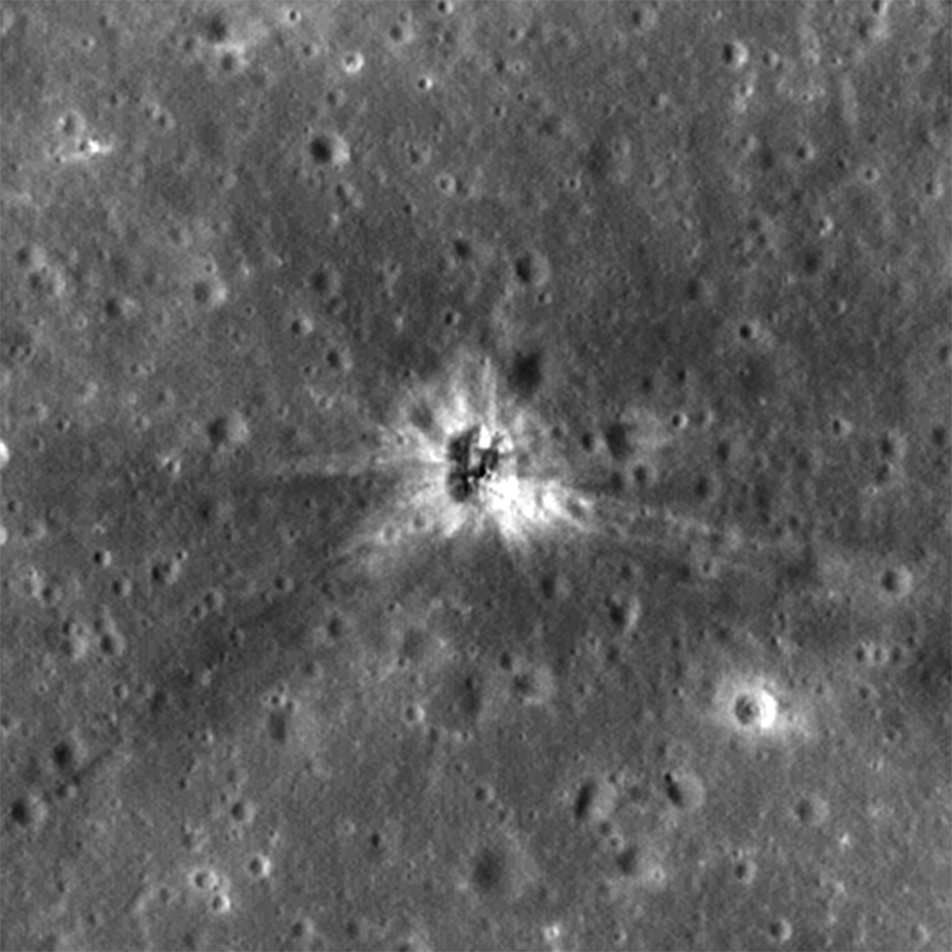
A decades old mystery is now solved! After many attempts searching through Lunar Reconnaissance Orbiter Camera (LROC) images, the Apollo 16 S-IVB rocket booster impact site has been identified. The site is on Mare Insularum about 260 km southwest of Copernicus Crater.
During the Apollo exploration of the Moon, beginning with Apollo 13, the massive, upper stage (known as the S-IVB stage) that helped propel astronauts to the Moon, were directed to impact the Moon. The energy from these impacts was measured by seismometers left on the surface (by previous Apollo astronauts) to understand the internal structure of the Moon. The locations of the impact craters, a total of 5, were estimated from tracking data of the booster collected just before impact. The LROC team found the other four craters early in the mission, however the Apollo 16 crater remained elusive.
In the case of Apollo 16, radio contact with the booster was lost before the impact and thus the impact location was only poorly known. Now, with high-resolution LROC Narrow Angle Camera (NAC) images the impact site of the Apollo 16 S-IVB stage was precisely located (1.921°N, 335.377°E, -1104 m elevation). In fact, the location differs by about 30 km from the Apollo-era tracking estimate. For comparison the other four S-IVB craters were all within 7 km of their estimated locations.

The Apollo 16 S-IVB crater is elliptical in shape, about 40 m x 30 m with a large mound in the center, and rays extending hundreds of meters from the rim. The craters from the booster impacts are unusual because they are formed by very low-density projectiles traveling at relatively low velocity (2.6 km per second, 5800 mph). The S-IVB booster can be imagined as an empty soda can hitting the surface - just an outer metal shell with very little interior mass (all of the fuel was used to send the astronauts toward the Moon and the tanks were empty). During the impact, much of the energy went into crushing the booster and only a shallow crater was formed. Finding and measuring spacecraft impact craters is useful because they provide scientists the chance to test numerical models of crater formation as their mass, density, and impact velocity are well known. These new craters also form the basis for long-term studies as to how craters degrade with time, a potentially useful tool applicable to the whole Moon and asteroid surfaces. In the case of the S-IVB craters, LRO based accurate knowledge of the position of the impacts (and the seismometers) may allow for a more precise determination of the interior structure of the Moon.
It took a long time to find the crater because it was so far from the estimated location. Each LROC NAC pairs cover area of 5 x 25 km to 10 x 50 km (depending on spacecraft altitude) and each pair of images consists of 500 million pixels. So there are billions of pixels to examine! Further complicating the search is the fact that there are many small fresh craters that have to be examined as the potential crater.
Browse the whole LROC NAC image:
Previous LROC Featured Images on S-IVB impacts:
Published by Mark Robinson on 2 December 2015